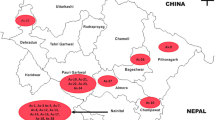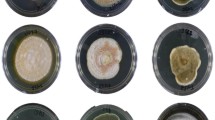Abstract
Early blight (Alternaria solani) is an important disease causing severe damage in tomato. The eleven isolates of A. solani designated as So, Dh, Sh, Va-5, Ka, Ma, Hy, Ba-1, My, Va-3 and Mi were collected from different agroclimatic conditions and these isolates were characterized for cultural, morphological, pathogenic and molecular variations. The pigmentation varied from yellow, brown, black, brownish to greenish black in isolates of A. solani on potato dextrose agar medium. In general, radial growth of all isolates ranged between 14.9 mm and 32.2 mm on PDA and 24.3 mm to 53.7 mm on three selective media i.e., ASM, V-8 juice agar and V-8 juice agar (synthetic) on the fourth day. The fastest radial growth was recorded in the So isolate and slowest in the Ka isolate on PDA, while isolates Dh, Ba-1 and Va-3 were recorded to be faster in growth on ASM, V-8 juice agar and V-8 juice agar (synthetic) medium. The thickness of conidiogenous hyphae varied between 1.17 μ and 9.56 μ, with maximum in the Va-5 and Ma isolates. Most of the isolates showed smooth mycelial growth with circular and irregular margin and without concentric zonation. Sporulation was not found in any of the isolates on four different nutrient media, whereas conidiogenous hyphal length was observed in V-8 juice agar medium only. Based on the pathogenicity, isolates of A. solani were rated as virulent or less virulent based on percentage disease incidence data. Molecular variability studies were also done to find out the best annealing temperature and eighty-six primers were screened to select for maximum polymorphism of DNA. The best annealing temperature was recorded between 32.5 °C and 34.0 °C for the pathogen, and most efficient amplification and polymorphism of DNA was found with random primer 5′-CGCGTTCCTG-3′.



Similar content being viewed by others
References
Bonde R (1929) Physiological strains of Alternaria solani. Phytopathology 19:533–548
Bose TK, Kabir J, Maithy TK, Parthasarathy VA, Som MG (2002) Vegetable crops, vol 1, p 69, pp 1–154
Castro MEA, Chaves GM, Zambolim L, Cruz CD, Silva DJH (1999) Effect of inoculum concentration on the resistance of tomato to Alternaria solani. Fitopathologia Brasileira 24:463–465
Castro MEA, Zambolim L Chanes GM, Cruz CD, Matsuoka K (2000) Pathogenic variability of Alternaria solani, the causal agent of tomato early blight. Summa-Phytopathologica 26(1):24–28
Cotty JP (1987) Modulation of sporulation of Alternaria tagetica by carbon dioxide. Mycologia 74:508–513
Datar VV, Mayee CD (1985) Chemical management of early blight of tomato. J Maha Agri Univ 10(3):278–280
Douglas DR, Pavek JJ (1971) A efficient method of inducing sporulation of Alternaria solani in pure culture. Phytopathology 61:239
Ellis MB (1971) Dematiaceous hyphomycetes. Commonwealth Mycological Institute, Kew, England, pp 464–497
Fourtouni A, Menetas Y, Christias C (1998) Effect of UV-B radiation on growth, pigmentation and spore production in phytopathogenic fungus Alternaria solani. Can J Bot 76:2093–2099
Gemawat PD, Gosh SK (1979) Studies on the physiology of growth of Alternaria solani. India J Mycol Plant Pathol 9(1):138–139
Gorgan RG , Kimble KA, Misaghi I (1975) A stem canker disease of tomato caused by Alternaria alternata f.sp. lycopersici. Phytopathology 65:880–886
Gupta DP, Nikhiraj NS (1972) Host relations in Alternaria blight of potato:germination of spore. J Bihar Bot Soc 1:22–26
Kuangai T, Oda Y (1969) Blue and near ultraviolet photo reaction in conidial development of the fungus, Alternaria tomato. Develop Growth Different 11:20–23
Kaoru O, Mitsuo N (1970) Effect of light on sporulation of Alternaria kikuchina TANAKA. Ann Phytopathol Soc Japan 36:11–16
Lukens RJ (1962) Photoinhibition of sporulation in Alternaria solani. Am J Bot 50:720–723
Manicom BQ, Bar-Joseph M, Rosner A, Vigodsky-Haas H, Kotze JM (1987) Potential applications of random DNA probes, and restriction fragment length polymorphisms in the taxonomy of Fusaria. Phytopathology 77:669–672
Morris PF, Connolly MS, St-Clair DA (2000) Genetic diversity of Alternaria alternata isolated from tomato in California assessed using RAPDs. Mycol Res 104:286–292
Neergarrd P (1945) Danish species of Alternaria, and Stemphylium. Oxford University Press, London
Pandey KK, Pandey PK, Satpathy S (2002) Integrated management of disease, and insects of tomato, chilli, and cole crops. Technical bulletin-9, 7 pp
Perez S, Martinez B (2000) Fungi associated with tomato early blight symptoms. Revista de Proteccion Vegetal 15:191–193
Perez S, Martinez B (1995) Selection, and characterization of Alternaria solani. Isolates of tomato. Revista de protection vegetal 10:163–167
Prasad B, Dutt BL, Nagaich BB (1973) Inducing sporulation in Alternaria solani I. Effect of water treatment. Mycopathol Mycol Appl 49:141–146
Prasad B, Dutt BL (1974) Inducing sporulation of Alternaria solani II. Effect of light. Mycopathol Mycol Appl 49:141–146
Rath GC, Padhi NN (1973) Sporulation of Alternaria solani in pure culture. Indian Phytopathol 26:495–501
Rodriquez ACM, Santana R (1991) Effect of new culture media, and temperature on the growth in vitro of Alternaria solani. Centro Agricola 18:86–88
Rotem J (1966) Variability in Alternaria porri f.sp. solani. Isr J Bot 15:47–57
Singh BM (1967) Inducing sporulaton of different strains of Alternaria solani II effect of ultra violet light. Mycopathologia 32:163–171
Sodlauskiene A, Rasinskiene A, Surviliene E (2003) Influence of environmental conditions upon the development of Alternaria genus fungi in vitro. Sodininkyste ir Darzininkyste 22:160–166
Stevenson RE, Pennypacker SP (1988) Effect of radiation, temperature, and moisture on conidial germination of Alternaria solani. Phytopathology 78:926–930
Vloutoglou I, Kalogerakis SN (2000) Effect of inoculum concentration, wetness duration, and plant age on development of early blight (Alternaria solani), and on shedding of leaves in tomato plant. Plant Pathol 49:339–345
Wang H, Zhang TY (2003) RAPD analysis on small spored Alternaria species. Mycosystema 22:35–41
Weir TL, Huff DR, Christ BJ, Romaine CP (1998) RAPD-PCR analysis of genetic variations among isolates of Alternaria solani, and Alternaria alternata from potato, and tomato. Mycologia 90:813–821
Acknowledgements
Authors are very thankful to Dr. Mathura Rai, Director and Dr. P. K. Pandey, Head, Division of Crop Protection, Indian Institute of Vegetable Research (IIVR), Varanasi for their constant encouragement and providing the resources to carry out the research work.
Author information
Authors and Affiliations
Corresponding author
Rights and permissions
About this article
Cite this article
Kumar, V., Haldar, S., Pandey, K.K. et al. Cultural, morphological, pathogenic and molecular variability amongst tomato isolates of Alternaria solani in India. World J Microbiol Biotechnol 24, 1003–1009 (2008). https://doi.org/10.1007/s11274-007-9568-3
Received:
Accepted:
Published:
Issue Date:
DOI: https://doi.org/10.1007/s11274-007-9568-3




